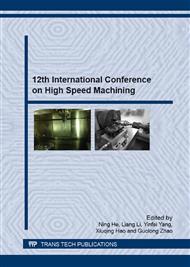p.468
p.476
p.484
p.493
p.501
p.509
p.522
p.529
p.536
Kinematical Smoothing of Rotary Axis near Singularity Point
Abstract:
This paper deals with singular configurations of a 5-axis machine tool in high speed milling which may lead to the appearance of large incoherent movements of rotary axes near singularity points. These movements generate slowdowns of the actual feedrate during the execution of the tool path, which affect quality and productivity. Thus, this paper proposes a method to detect these behaviors during machining simulation and correct the tool path. Unlike the literature methods, this correction consists in modifying the tool axis orientation by going through the singularity point while respecting maximum velocity, acceleration and jerk of the rotary axis. For that purpose, the initial articular positions of the rotary axis near the singularity point are fitted with B-spline curves, modified and finally discretized for linear interpolation. Experimental investigations on a test part are carried out to show the efficiency of the method.
Info:
Periodical:
Pages:
501-508
Citation:
Online since:
January 2016
Price:
Сopyright:
© 2016 Trans Tech Publications Ltd. All Rights Reserved
Share:
Citation:


